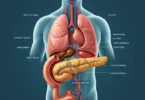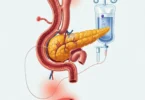Pancreatic Cancer: Surgery
Chemotherapy for Pancreatic Cancer
Radiotherapy for Pancreatic Cancer
The effect of radiotherapy based on the fact that it destroys cancer cells. In pancreatic cancer radiotherapy are used usually comes in combination with chemotherapy (radiochemotherapy).
The advanced tumors that could not be promising with surgery may be first treated with a so-called neoadjuvant chemoradiotherapy. The tumor and the tumor strands in the surrounding tissue can be reduced by using this technique. It increases the chance that the tumor is completely removed by surgery.
Except for the reduction of the tumor, radiation therapy is also used to remove tumor symptoms eg pain (palliative treatment).
Targeted Therapies
In addition to the previous standard method of treating pancreatic cancer, new methods are designed to improve the treatment of this disease. A new therapeutic approach are the so called targeted therapies. They engage different pathways of tumor metabolism and therefore work intensively against malignant tissue and spare healthy tissue largely. Active ingredients from the group of targeted therapies are directed against different tumor metabolism, for example, they hinder factors that promote tumor growth, inhibit the blood supply to the tumor or prevent the transmission of signals between tumor cells.
The Tyrosine Kinase Inhibitor Erlotinib is currently the only agent from the group of targeted therapies, which is approved for the treatment of pancreatic cancer.
Tyrosine kinase inhibitor erlotinib
Patients with locally advanced, unresectable or scattered pancreatic cancer can be treated with a combination of the standard chemotherapeutic agent Gemcitabine and the Tyrosine Kinase Inhibitor Erlotinib. Erlotinib work by targeting binding sites of growth factors on the surface of cancer cells. These binding sites are often formed by the tumor cells in excess. The tyrosine kinase inhibitor Erlotinib inhibits the binding sites mediated by the signal transmission, whereby the growth of the tumor cells is blocked.
Treatment with erlotinib alone with Gemcitabine extend the survival time of patients with locally advanced or scattered pancreatic cancer compared to chemotherapy.
Side Effects of Targeted Therapy
Erlotinib is in tablet form. Most frequent side effect of treatment is an acne-like rash, which is, however, in most cases mild and requires no special treatment. It even turned out that the rash is a sign of a particularly good response to treatment.
Palliative Therapy
If the illness is already so advanced that a cure or an effective tumor treatment are no longer possible, than the palliative treatment is used. Palliative therapy , is particularly important. Its goal is to treat the tumor related pain and discomfort and alleviate.
For palliative care include the treatment of tumor-related complications and pain, the pain, the enzyme, diabetes and vitamin therapy, nutrition, and psychosocial counseling or care of the patient, eg in the context of self-help groups or special mental health facilities.
A carcinoma of the pancreas, which cannot be removed is causing complications with time because of the bile duct, the gastric outlet or duodenum may be narrowed by the tumor. May be result in nausea, vomiting or jaundice. While previously a major operation was necessary in any case to alleviate the symptoms, it is now often possible to help the patient through small surgical or endoscopic procedures.
So the doctor can bring about an endoscope, a tube of plastic into the bile duct (called Stent or endoprosthesis) to counteract a constriction. Even the entrance to the stomach can be widened. The relief of a jammed bile duct is also possible from the outside through the introduction of a drainage tube through the skin into the bile duct.
If the stomach is starting strongly concentrated, the patient may be further fed (enteral nutrition) by a thin feeding tube that is inserted through the nose or through the abdominal skin in the small intestine.
Pain Treatment for Pancreatic Cancer
In the advanced stages of the cancer the influence of the pain is stronger than the tumor itself. One of the most important measures in this case is the effective pain relief. Cancer pain in most cases can alleviate well with the medications and methods available today. Morphine is used as painkiller in severe pain.
If the tumor extended to the bone ( bone metastases ), bone-strengthening substances in the form of infusions can be administered. These drugs increase the stability of the bone and reduce the pain.
For more general information:






